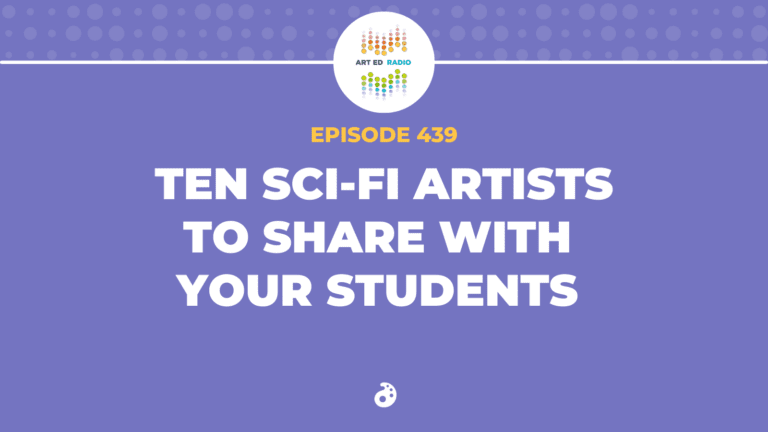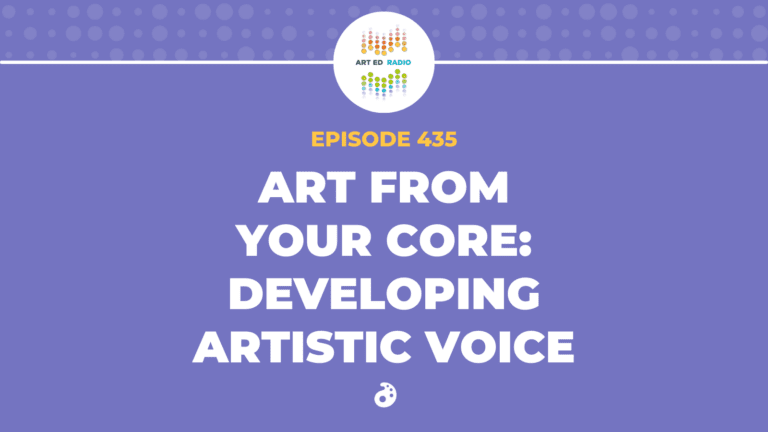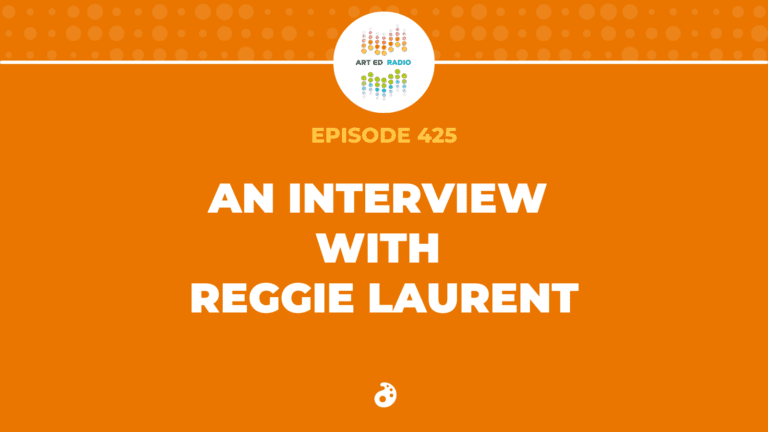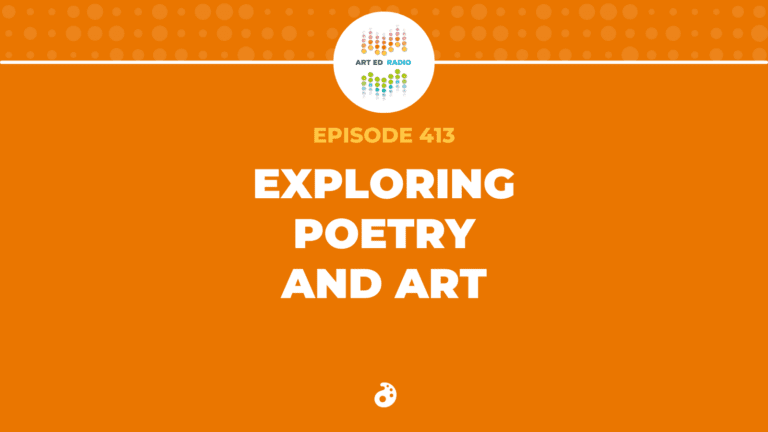Could the most dangerous store for an art teacher to visit actually be the bookstore? For Cassie, it is, and in this episode, she talks about some of her favorite children’s books. Listen as she discusses her favorite children’s books, her favorite authors, and how she uses books in her classroom. Full episode transcript below.
Resources and Links
- 10 New Books You Need in Your Library
- 5 Ways to Bring Literacy into Your Classroom
- 70 Children’s Books About Famous Artists
- 15 Books, 15 Art Lessons
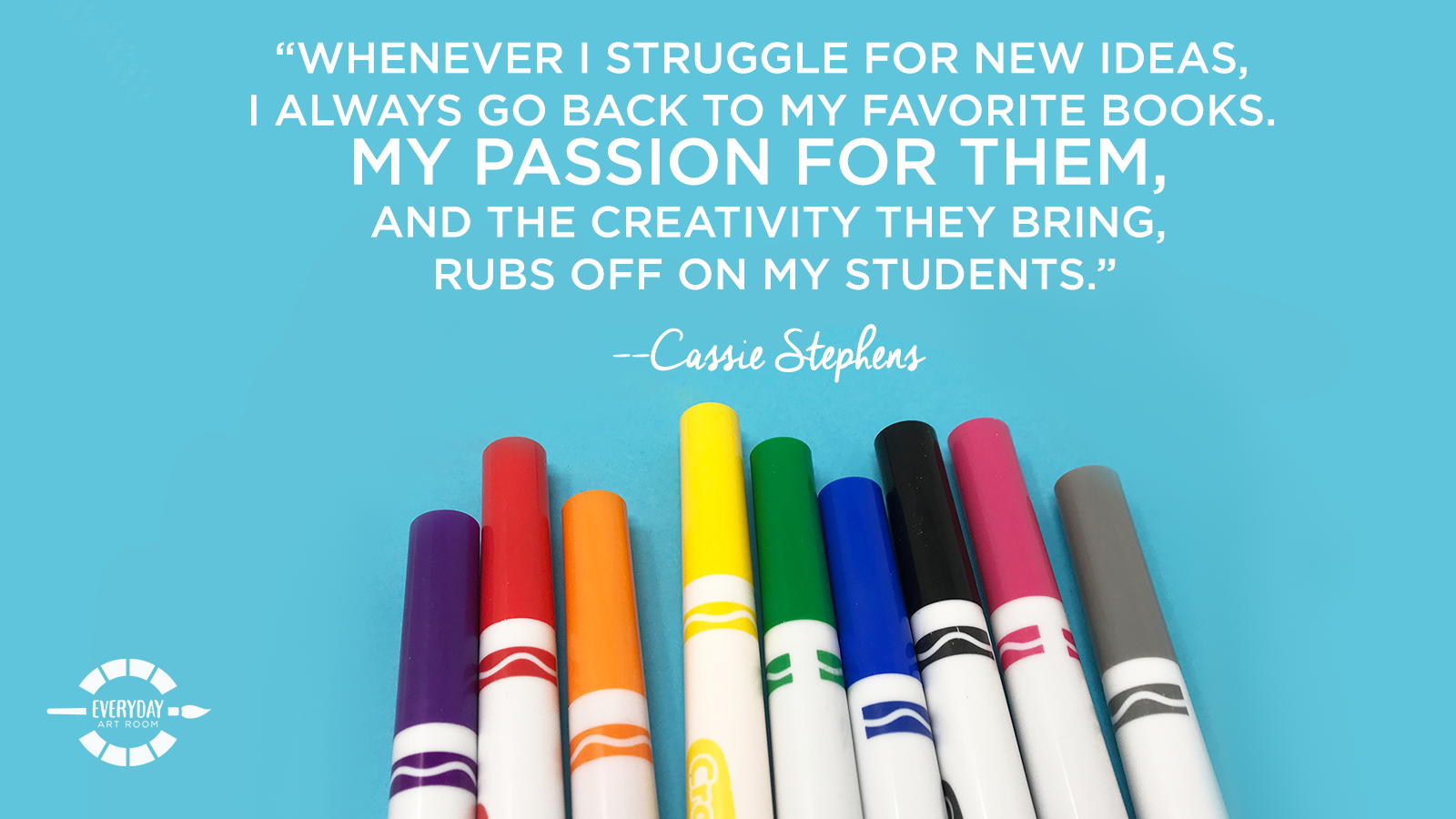
Transcript
Cassie: What is the most dangerous place for an art teacher to venture into? I know what you’re thinking. Like, “Art supply store, craft store.” Think again. For me, my weakness, my art teacher Achilles’ heel, it’s the bookstore. Sadly, there’s not too many of those around anymore it seems, but when I do venture into one, it is a dangerous place, and I almost always have … I go into some sort of crazed blindness. I just start loading up books. Next thing you know, I’m at the counter handing them my credit card. I just can’t help it. Children’s books are amazing, and I use them so much in my art room that I recently decided to put together a list of some of my favorites.
I thought, “Oh, I can do that. That’ll take me a short while to jot a couple down and I’ll share ’em with all … Y’all five people that are listening”, and next thing you know, I’m sitting here for the last hour and probably more, keeping adding more and more and more books to my list. Today, I’m going to share with you a big, fat, hairy list of my favorite children’s books. Books that I love to share with my kindergarten through my second grade students. This list is so massive and yet it’s still doesn’t even include books about artists. I had to chuck that list out and I will have to share it in a future blog post, so get that pen ready. Listen up, I’m going to be sharing with you my favorite children’s books for art teachering.
I’m Cassie Stephens, and this is Everyday Art Room.
Okay, so I’ve kind of managed to break my lists of books down into categories, and I’m hoping that as I share those categories with you, it will make a little bit of sense. So many of these books I’m sure that you already have, but I have recently discovered a bunch of books that were written within the last couple of years that I am loving, and my kids, it’s those kind of books that when you’re finished reading them, the kids say, “Read it again.” If I were a book author, that would be like the best sentence in my life, read it again. I’ve got a couple of books in this list where as soon as I’m done reading, no matter what age level, that is exactly what they say, so I’m so excited to share those with you.
I thought I would start with the classic authors. I’ve been teaching for a million years, so my reach goes back pretty far and a lot of the books that I bring into my art room are books that I remember being read to me, authors that I absolutely loved as a kid. For me, at the very top of that classics lists … What I’m about to share is a list of about a dozen authors where you could buy any one of their books and it would be an awesome asset to your art room. These are my rockstar, classic rockstar book authors. For me, like I said, at the very top of my list because he was my favorite when I was growing up, Shel Silverstein. I know you guys have heard me talk about him before, but his books of poetry are so fun, so quirky, so enriching for the imagination. Even up to my fourth grade kids, they will ask me to “read that weird poetry book” while they’re working.
These poems are just the best, and even on a day when you have free times or perhaps you need a sub plan in a pinch, you could have a sub or even you could read one of his poems to your students and let them illustrate it. Of course, he does have illustrations in his books as well. He’s got three great poetry books. My favorites are Where the Sidewalk Ends and Light in the Attic. His books have been around for years. Like I said, I had teachers reading them to me when I was in elementary school. Every one of his books I’ve managed to find at the thrift store.
That’s a good side note. Let me just take a little break from my list right here and say books can get super expensive, and they should be. Those authors work very hard to write those books. However, we teachers don’t exactly have a giant budget for such things, so whenever you can buy books used, whenever you can search out estate sales, garage sales … I know our local library once a month on Saturdays just sells books very, very inexpensively. Even online, you can find a lot of resources for buying used books, so definitely check that out instead of just like hopping onto that one giant website that we all love and use and purchasing from there and paying a little bit more than you necessarily have to.
Okay, back to my list of classic rockstar book authors. I love Ed Emberley. He’s most famous probably for the thumbprint books where you can do a thumbprint and he shows you different ways to change your thumbprint into different silly characters like animals or creatures. His favorite book of mine is Go Away, Big Green Monster. That is definitely a book that kids always say, “Read it again”, and I’m gonna come back to that book in a little bit, but if you don’t have that one, put that one at the top of your must-get list.
Eric Carle, you cannot go wrong with any of Eric Carle’s books because they are a feast for the eyes, especially when you’re introducing your students to collage. Tomie dePaola, I love his books. He is an author that’s been around for a very long time. A couple of his … My favorites of his are The Art Lesson, which is a great book to read to your students at the beginning of the year, and I really love The Legend of the Indian Paintbrush.
Okay, so here’s an author that you might not be familiar with, but she is definitely in my rockstar category. Her name is Tana Hoban, and her books usually are more about the imagery, not so much about the words. They’re usually photographs. In fact, I think all of her books are photographs, and they’re simply beautiful. She has … My two favorites of hers are Look! Look! Look! and Look Again! Both of these books really share with students ways to look closely, investigate the line, the texture within a photograph and then she shares with you the expanded version of the photograph so you can actually see what it is. It really is such an awesome book and I cannot encourage you enough to get it. It might be a little tough to find, so you might have to investigate on those used bookseller websites.
Peter H. Reynolds. The guy … Everything he writes is magic. Everything he illustrates is gorgeous. Of course, my favorites of his are The Dot, Ish, and Sky Color, but really all of his books can be used in your art room.
Leo Lionni, another oldie but I absolutely love all of Leo Lionni’s books. I just love the illustrations. They’re so simple. They’re so … I don’t want to say child-like, but they are, so relatable for our students. Little Blue and Little Yellow is a very sweet book. It also talks a little bit about color mixing, as well as A Color of His Own, which is all about a chameleon who discovers his own color. Like I said, he’s one of those authors where you could get any of his books and they’re all amazing. In fact, Swimmy is another awesome book of his.
Last but not least in my rockstar category is Lois Ehlert. One of my favorite books by Lois is one called Circus. I love using this book when I’m talking with my younger students, particularly kindergarten about shapes, because it’s all about shapes. It’s another one of those books where it’s very flat, very graphic, easy for my younger students to see and visually understand. She has another book that’s called Planting a Rainbow, which is also a great book to share with your students.
Okay, now I’m switching gears. I want to share with you my list of classic books. Books that I’ve been reading to my students for a while, I always come back to, and they always love. All right, this one’s going back real far. Harold and the Purple Crayon by Crockett Johnson. Such a fun book. Great book for introducing line and how line can be used to create shape and shape can be used to make pictures, and like again, it’s such a fun book to just sit and look at. It’s visually just adorable.
The Day the Crayons Quit, I mean, that one, amazing. Drew Daywalt is the illustrator and Oliver Jeffers I believe is the author of that one. So much fun and just funny to read. Again, that’s one when I’m finished with it, the kids are saying, “Read it again.” My favorite part about reading these books is just pouring all of my energy into the different kind of characters and the different voices, all of those things which I love to do and the kids, of course, eat it up.
This book I’ve had forever. This book I would also put … I would put all of these at the top of the list, but this one is my favorite book to read out loud to kids. Are you ready? It’s called Purple, Green, and Yellow. It’s by Robert Munsch. He should also be in my list of fave children authors because his books are so funny. He’s this Canadian author who started out just telling stories to kids to make them laugh at the local library, and somebody suggested that he write them down, and then the rest is history. This book of his, Purple, Green, and Yellow, I love reading this book to my students. It just gives me so much joy because it’s so stinkin’ funny.
Art Dog is another classic book that I’ve had in my library for years. Art Dog is by Thatcher Hurd. One of the reasons I love Art Dog is not only is it cute, but there’s also all of these amazing art history references throughout the book, which is fun for the kids to spot and point out.
Art Teacher from the Black Lagoon, I waited for this book forever. There’s so many. Librarian from the Black Lagoon, Teacher from the Black Lagoon, Principal from the Black Lagoon, and I was like, “Where’s the art teacher?” Finally it’s here, and it is by Mike Thaler.
Okay, now lets’ talk about books that I love to use at the beginning of the year to introduce my students not only to art and art class and the creative process, but also to just realize that art doesn’t have to be perfect. The best book for that when I’m starting off my year and I’m introducing my kids to growth mindsets and having an open mind and really not getting closed in on that fixed mindset … The best book I have found is, of course, Beautiful Oops. Love Barney Saltzberg’s book. That is another one that’s at the top of the list. I love … My kids love this book.
Of course, The Dot and Ish by Peter H. Reynolds are must-reads at the beginning of the school year, particularly The Dot, since Dot Day is in September. What Do You With An Idea is really an awesome book because so many kids … We get ideas, we don’t know what to do with them. We don’t know how to bring it to fruition, how to make it a reality, and this book kind of talks the kids through it. It’s by Kobi Yamada and Mae Besom.
Art by Patrick McDonnell is a really fun book. Another classic that, again, I’ve had for years, I read it every year. It’s so great at the beginning of the year, it’s called The Big Orange Splot by Daniel Manus Pinkwater. I love this book so much. So many lessons can be taught from this book, but the real takeaway is just discovering who you are and making sure to just follow that path. Go in the direction that you want to and don’t feel obligated to be just like everybody else. I mean, that’s like the takeaway you want from every art class, so The Big Orange Splot is gonna help you share that idea with your students.
Now, when I’m introducing color to my kids, these four books are the ones that I just … I go directly to, and Mouse Paint, especially with my kindergarten, but I read it to my first graders, too, it’s a great review. Mouse Paint is by Ellen Stoll Walsh. She also wrote a book about shape called Mouse Shape, which I don’t have and I just learned that by doing … Creating this list, so guess I’ll be popping that in my little shopping cart. Mouse Paint, I love, Simple, clean, beautiful, graphically awesome to look at. Yeah, it’s also one of those fun books that the kids love to hear again and again.
Okay, I’m about to share with you a book that blows my students’ minds. Two of them. They honestly think that these two books are magic. Now, it is all about the delivery of how you read it, but they cannot get over how awesome these two books are. Press Here and Mix It Up. If you don’t have Press Here and Mix It Up by Herve .. I’m gonna mispronounce his name … Herve Tullet, T-U-L-L-E-T. He’s French. If you don’t have these two books, you’ve gotta get ’em. Really, all of his books are awesome. He has another book that is called Art Workshop for … I think it’s called Art Workshop for Kids, and that’s more of a teacher book. It’s a book for us. You guys, that book is amazing, also, I’m telling you, and he’s a fabulous artist to follow also on Instagram. Or if you’re in a big city and he happens to have an art exhibit there, go to it. Go to his workshops. He’s a genius. I cannot stress how much I dig this dude and his books.
Ain’t Gonna Paint No More. Oh my goodness. When he almost puts paint on his butt, my kids think that is the most hilarious thing on the planet. It is by Karen Beaumont and David Catrow, and it’s also a kid fave.
Now, let’s talk about lines. Right now, I’m kind of dividing my little categories up into the elements of art, so lines. Lines That Wiggle by Candace Whitman. The Line by Paula Bossio … Bossio, and A Line Can Be by Laura … Oh, y’all, she’s got a very interesting last name that I’m not gonna attempt to pronounce. These three books are fairly new. Lines That Wiggle has been around for a little while, but The Line and A Line Can Be are two new books on the scene and they are so much fun. A Line Can Be is a very, very simple book. It would be good for your pre-K and beginning of the year kindergarten set because it’s a lot of visual imagery and not a lot of words. The Line by Paula Bossio is similar … It’s like a modern day take on Harold and the Purple Crayon. Lines That Wiggle is just an adorable book to have.
Some books on shape that I absolutely love, Perfect Square by Michael Hall and Go Away, Big Green Monster. I’m telling you, that book … That’s another book like Press Here and Mix It Up, Go away, Big Green Monster, the kids think that that book is magic. They can’t comprehend how the shapes are vanishing and so it blows their mind. It’s so fun to read.
Other books about shape, like I was mentioning earlier, Lois Ehlert’s Circus is really great because it’s very simple and introduces lots of shapes. A book that I just recently bought is Circle Rolls by Barbara Kanninen … Kanninen. There’s a lot of N’s in here name, and her first name’s Barbara, and it’s called Circle Rolls. I love a book that rhymes. Ain’t Gonna Paint No More rhymes also, and I absolutely love it.
Why I love books like that is because I love books that I can have the kids interact with me with, so if I’m reading a book that rhymes, I will say this book is a rhyming book. Let’s talk about what that means, and then I’ll pause and let them attempt to fill in the rhyming book. Or if it’s a book that repeats, it has the same kind of catchphrase like Ain’t Gonna Paint No More or Purple, Green, and Yellow, those books have a similar phrase that they repeat, so a lot of times I’ll get the kids to interact with me with that. That’s a whole ‘nother podcast, how to read a book in a really fun and engaging way, so maybe we’ll chat about that in the future.
Okay, here’s my last list. Books with a message. Artsy kind of books, but they kind of deliver a powerful punch as far as like the underlying meaning goes. I’m Not Just A Scribble by Diane Alber. She’s also written two other books, one called Snippets. It’s about collage. Another one called Splatter, which is about paint. I’m Not Just A Scribble is precious, and I really recommend you get that for your library.
Paint Is For Boys by Rob Perlman and Etta Cabin, awesome book. Kind of breaking down those barriers that colors are for certain genders and what is that all about, it’s awesome. Red is another book. Red is a book by Michael Hall. It’s all about a crayon who doesn’t feel like he’s the color he should be, or she should be. Get it, read it. You will love it.
Linda Krantz has some great books. One is called Only One You and You Be You. I love these books so much because the illustrations are of painted rocks, and if you’re gonna want to do a project like that with your students it’s a great couple of books to have in your library. All along with the message of You Be You and Only One You.
Swatch: The Girl Who Loved Color by Julia Denos is a great book, and I love reading this book before talking to my students about the artist Sandra Silberzweig because she has Photosynesthesia …. I’m mispronouncing that, I’m almost positive, but that means she sees more colors than the average person, which is a hard thing to describe to kids. They’re like, “Say what now?” Reading a children’s book that also introducing a child … Well, I don’t want to say she has … Swatch has those this, but it’s kind of like a similar motif. It really helps them understand that better.
Perfect by … Okay, this is a book I just bought at the bookstore … These two books, Perfect by Max Amato and The Case of the Missing Chalk Drawings by Richard Byrne. They are just so much fun. Brand new books that are out there and I love them. Perfect is about an eraser who wants everything to be just perfect, and The Case of the Missing Chalk Drawings is just a fun book to read, especially if the kids are getting ready to use chalk. I love any kind of animated art supply book.
Last but not least on my list, another new book, Brick: Who Found Herself in Architecture by Joshua David Stein and Julia Rothman. Ooh, now you see why I have no room or time to share with you my favorite books on introducing artists to kids. That was a lot of books. If you have … Or if you don’t have some of these books in your library, like I said, find some places … Definitely check them out first. Go to your local library, take a look through them. You know what’s gonna work better for your kids and what your kids are gonna really respond well to, but it always surprises me with just when I think I’ve found a book that, “Oh, my kids will love this”, or, “This book seems a little too basic for my kids”, those are the ones that will surprise you. It really, truly is all about the delivery and how you read that book.
Thank you guys for letting me share my lengthy list of favorite elementary art books.
Tim: Hello, this is Tim Bogatz from Art Ed Radio. Thank you as always for listening to Everyday Art Room with Cassie here. Now, today I want to talk to you again about Art Ed PRO, the essential subscription for professional art teachers. It is on-demand professional development with video tutorials, lessons, downloadable handouts, and all kinds of other resources to help take your teaching to the next level.
Now, as of this week, the library now has 96 learning packs in it and it will continue to grow. The new learning packs that came out on April 1st are on planning artworks with students, the connections between art and math, and how to teach encaustics. Now, with so many topics already covered and three more packs released on the first of every month, Art Ed PRO is the PD you need when you need it. Make sure you check it out and start your free trial at the artofeducation.edu/pro.
Now, let me give it back over to Cassie so she can finish up the show.
Cassie: Hey, let’s take a quick little dip into the mail bag, shall we? This first question comes from Jamie. Jamie says, “I do one school-wide project every year and I was thinking about doing a similar project to your modeling portraits. I have a few questions that would really help if you could take a few minutes to respond.” Well, my pleasure, Jamie. I certainly will try. “Do you think it would be age appropriate for all first through fourth graders?”
Okay, if you’re not familiar, I did a project last year … I think I did it for the second time last year, I don’t know. I have a project on my blog and it’s a modeling clay portrait project. My students did modeling clay portraits and they are flat, not three-dimensional, and it’s on a very small mat board surface. I think that ours were three-inch or maybe four-inch squares. They used the modeling clay, any modeling clay, like whatever you can get your kitten mittens on at your local Walmart or craft stores. They made portraits of people who work in our school, but then they’ve also done self-portraits as well.
Modeling, as you know, never ever dries, so when they were finished with their portraits, we covered them with Crayola’s … It’s like a glaze, a model … I think it’s called Model Magic Glaze, and it makes the portraits … It’s almost like a clear nail polish. It puts a coating on them that makes them nice and hard. I have done this project with my third graders and my fourth graders, so to answer your question, I would stick with the slightly older grades. It could be a little bit difficult for your younger students to kind of handle making really small features out of that modeling clay. I know that some of my students struggled with that a bit and those are my older students.
I was, like I said, working on a really small surface. If you’re wondering why I used such a small square, well, because they have to cover the whole square with modeling clay. That’s a lot of clay, actually. It actually takes up quite a bit, and it’s a little bit of work, so that’s why I used that smaller scale, and that’s what I would recommend for the age groups.
Her next question is, “Do you need to keep the clay wet between classes? Or can you add wet to dry?” Since this is modeling clay, there’s no water needed. You don’t have to cover it up. Modeling clay never, ever dries, so that was the beauty of it. It took the kids a couple of art classes. We didn’t have to put it in a bag. We didn’t have to seal it up. We didn’t have to drape a wet paper towel over it. That was my life last week during regular clay week. This stuff, you can leave it out, same with the clay, all the time.
Her last question is, “Do you have any idea of how much clay you purchased for how many students?” I teach … Let’s see, for that project I’d probably have about 80 fourth graders, and I think I bought … Gosh, I can’t really say. Three sets of the … It comes in a pack of colorful clay, so I think I bought three sets of that, and then modeling clay, you can also just buy it by color, so I know I bought an extra stash of black, white, and a couple of different kinds of skin tones. They had a peach and then they also had a brown. We did talk a lot about how to blend those two colors together to get a skin tone that either matched us or the person we were created the portrait with.
I got a lot of questions about that project when it came to, how much do I purchase? Short answer is, I don’t know. Good news is is that this kind of clay, you can keep it in your cabinet. You don’t even have to like wrap it up. Save it for next year, so it’ll still be ready to use next year if you do overbuy. I always lean on the side of purchasing more rather than less.
If you have a question for me, well, then you should send it my way. You can find me at everydayartroom@theartofed.com.
The other day I was asked, “If you had to run out of your room and you could never come back, some sort of crazy art teacher catastrophe happened and you had to get out as fast as you could, what would be the one thing that you would grab?” I just remember turning in circles in my room. If you’ve seen my art room, there’s so much stuff in there. I might be a hoarder. Like, you all know I am a hoarder, so … I love all of my stuff. It’s like my children. I have to keep all of it, but if I could only grab one thing, it would be all of my books. All of them.
If I could only grab some, I guess it would probably be those stinkin’ Shel Silverstein books. I always go back to them. I’m telling you what, whenever I struggle with teaching or trying to come up with ideas of what to share with my students, I always just think, “What did I love as a kid?” When you share that with your students, those favorite books that you had as a kid, those beautiful illustrations that you just loved, the ones that inspired you to pursue art, that’s what you share with your students ’cause you’re gonna be so stinkin’ passionate about it that it’s gonna rub off on them. When unicorns start breathing rainbow fire all over my art room and I’m running out of there like a mad woman, I will have my Shel Silversteins tucked under my arms.
Y’all have a great week, and I’ll talk to you soon.
Magazine articles and podcasts are opinions of professional education contributors and do not necessarily represent the position of the Art of Education University (AOEU) or its academic offerings. Contributors use terms in the way they are most often talked about in the scope of their educational experiences.
